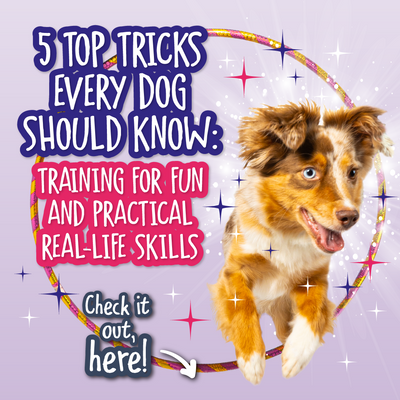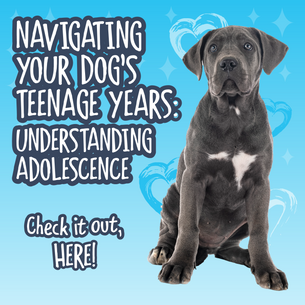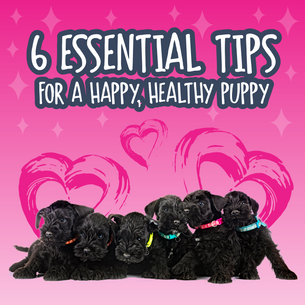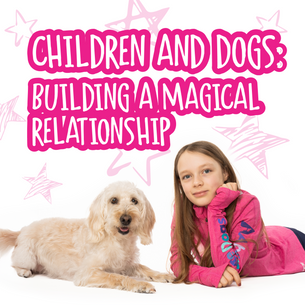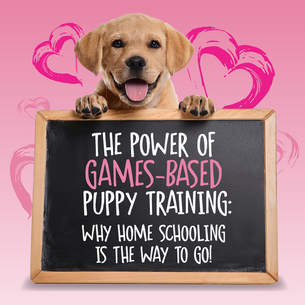Have you ever fancied diving into the world of trick training with your dog? If you've come across our super trick training playbook, There's A Trick For That! you'll know that there are SO many awesome benefits to trick training.
From strengthening your relationship with your dog and providing mental stimulation to enhancing your skills as a trainer and refining your mechanics, the benefits of trick training go way beyond simply teaching your dog to do something that looks impressive!
As well as being a lot of fun, training “tricks” can have surprising benefits for a whole array of dog behaviour struggles, and perfectly complement your everyday training.
Optimism & Confidence
Tricks are a brilliant way to boost your dog’s optimism and help them feel like a superhero. When your dog masters a new trick or learns to incorporate a new piece of equipment into a skill they already know (especially something dynamic like a skateboard), they gain confidence. Providing you go at your dog’s pace and keep it fun, you will see your dog’s optimism skyrocket.
Relationship & Teamwork
Learning tricks gives you a whole range of new ways for your dog to work with you and earn positive reinforcement. This is a brilliant way to build your relationship and help you learn to communicate effectively with your dog. Trick training is also a super way to increase your dog’s focus and engagement with you and strengthen your bond.
Trainer Skills & Mechanics
Teaching tricks is a great way to hone your own mechanics too. As you work with your dog and discover their learning style, you’ll become more proficient with reward delivery, placement, and overall mechanics, and learn to adjust your methods to help your dog succeed. Whether it’s luring, shaping, capturing, or target training, every dog is different. Trick training also teaches you to be precise with marking and rewarding, so your dog understands what is being asked and rewarded. The more you and your dog work on different skills and tricks, the quicker they will learn and the better you’ll become at teaching.
Mental Stimulation
Dogs have a huge capacity for learning, so training tricks is an excellent way to keep your dog’s mind active and give them a brilliant mental workout as they learn 'how' to learn.
Body Awareness & Injury Prevention
Tricks can improve your dog’s overall body awareness (proprioception), which is crucial for injury prevention. Many tricks build muscle tone, stamina, flexibility, balance, and concentration, all contributing to overall health and fitness. By teaching your dog to think about their movements, you help them become more aware and controlled, which is especially valuable for dogs that are overly adventurous or don’t always show any natural regard for their own safety when racing around, leaping off things or over things.
When considering how to set up your sessions safely, be mindful of the surface you’re working on, the environment, any existing injuries or conditions your dog may have, and whether the trick is suitable for their age and body conformation. Remember, an appropriate warm-up is key to preventing injuries. Some gentle lead walking before you begin will get your dog’s body moving.
Life Skills
Even more than all that, tricks reinforce skills that carry over into everyday life with your dog. Want a better behaved dog? Trick training could be the key! Teaching new tricks builds a powerful reinforcement history of your dog working with you, focusing on you, and being able to work around distractions – all of which are vital for those everyday skills we expect from our dogs – from loose lead walking and great recall to the ability to hang out calmly and ignore distractions. Trick training can even improve reactivity and help tackle behaviour struggles!
Tricks with Real Life Purpose
If you’re familiar with the absoluteDogs training approach, you’ll know that we focus on building the concepts every dog needs to navigate life, handle different situations, and make appropriate choices without constant input.
So how does that relate to trick training?
Think of any trick you’d love to teach your dog, and consider all the skills they might need in order to successfully learn and perform that trick. These might include…
Focus: Your dog’s ability to stay focused on you, or on a task, while thinking clearly about the instruction you are providing.
Confidence: Your dog’s willingness to try new things, offer behaviours until they work out the “rules” of the game, interact with novel objects and learn to use their body in new ways.
Grit: Your dog’s ability to persevere and keep trying when presented with a challenge or no immediate reward.
Body Awareness: Your dog’s understanding of where their body parts are relative to them and the surrounding environment, and to move them safely and thoughtfully.
Proximity: Your dog’s value for staying close, checking in with you regularly and seeing you as the very best source of fun.
So many tricks can look like cool party tricks, yet they can also benefit and complement your everyday training with your dog by boosting those all-important concepts in a fun, rewarding way.
In fact, choosing tricks that you know are going to be purposeful for your dog and the skills they need to navigate life and handle the situations they are going to find themselves in like a pro is one of the main reasons we love to train our ‘trick’ behaviours. It’s the very foundation of our super trick training solutions.
Let’s take a look at five top tricks that every dog can benefit from learning, and explore the real-life benefits.
Top Trick #1: Middle
One of our absolute favourites, Middle is a super trick where you teach your dog to stand between your legs, facing forwards. Great for boosting concepts including optimism, engagement, proximity and disengagement, Middle teaches your dog:
- To LOVE being close
- That coming back when called is FUN!
- That being with you is the SAFEST place to be!
It’s fun and easy to teach – and if your dog is too big to stand in position between your legs, “Side” is a great alternative.
Step 1
Begin with food in both hands. With your dog facing you, lure them around behind you with one hand. With the other hand, reach between your legs from front to back and guide them between your legs until they are standing in Middle. Feed them in this position to reinforce it as the place of value.
Step 2
Release them from position by throwing a piece of food ahead of them. As they come back towards you, lure them into Middle again. Feed in position to keep building the value.
Step 3
Build flexibility by bringing your dog into Middle from both sides of your body. Put lots of value into the static position and begin to build some duration into the behaviour. You want your dog to know that Middle is a great place to be. Aim to keep your dog standing so you can level up and take your Middle on the move once your Middle is solid.
Step 4
Gradually fade out the very obvious lure once your dog is seeking out that position. Try a slow lure without food in your hand and reward as soon as they’re in position. You’ll eventually be able to fade out the hand lure so they learn to respond to just a subtle hand gesture.
Step 5
When your dog is consistently coming into Middle on a visual cue, you can introduce a verbal cue to name the behaviour.
New cue (verbal) > Pause > Old cue (visual)
Step 6
When your dog has mastered the behaviour, you can start taking it to the next level. Can they catch in Middle, or switch from stand to sit to down? How about adding a little movement?
Inject some fun into your recall with an unexpected Middle cue, or boost your dog’s joy at seeking you out and hunting you down with a game of Middle Bowling where you release them from Middle, dash away and see how fast they can find that valued position, before doing the same again!
Top Trick #2: Feet On Mine (“Toes”)
Levelling up on Middle, this is a fun trick where you teach your dog to pop their front paws on your feet.
Fantastic for dogs who need to think a little more about where their paws are, it increases body awareness and teaches them to mirror you and be more aware of your movements – especially if you take it on the move!
As a real life skill, it’s perfect for dogs who are a little “Naughty But Nice”, sniffy, easily distracted or struggle to disengage from the environment and benefit from being anchored while distractions go past – as well as for dogs who need to grow a little more value for hanging out close.
So how do you teach it?
The foundation is a solid Two Paws On, so your dog understands the idea of putting their front paws on an object. If you and your dog are new to trick training and need to brush up on some foundation layers, you’ll find comprehensive step-by-step instructions in our super tricks book, There’s A Trick For That! – as well as alternative methods for teaching all the tricks we cover in this blog.
And of course Games Club – the home of games-based training solutions – is jam packed with all the foundational games and strategies you need for trick training success – and dog training success!
Step 1
Warm up with a game of Two Paws On. Use a variety of objects to make sure your dog really understands and has value for putting their front paws on different surfaces, heights and shapes of stable objects.
Step 2
Now play a few rounds of Middle. Feed in position to reinforce the value.
Step 3
Position your Two Paws On object between your feet and invite your dog into Middle. If you have sufficient value for those two foundational layers, most dogs will naturally choose to stand with their front paws on the object. This introduces the idea of standing in Middle with paws off the ground on an object (you will eventually transition this to your feet).
Step 4
Once your dog has lots of value for putting paws on an object between your feet, swap out the object for your feet, turned inwards, toes touching. Cue your dog into Middle and you should find that the learning transfers so they stand with paws on your feet.
Step 5
Over a number of sessions, start moving your feet out towards their normal position. Reward your dog for continuing to seek out those foot targets and placing their paws on your feet.
Top Tips
For very literal dogs, it can help to remove your shoes (or use a second pair of shoes) and pop those on the floor between your feet for your dog to target as a way of transitioning from feet on a block or more typical foot target in Middle, to the slightly more unusual idea of putting their paws on your feet / shoes.
If you find that your dog puts both paws on one of your feet rather than splitting their front legs and targeting one foot with each paw, it can help to work on this element of the trick separately, so your dog understands that their front paws can work independently of one another. Use paw pods, small blocks or even cereal bowls to build this understanding and then try again.
Top Trick #3: Retrieve
Retrieve is such a valuable skill for every dog to learn. Teaching your dog the trick of bringing something to you is not only the foundation of a really reliable recall, it also allows you to expand to so many different objects and aspects of life.
From holding an object in a photo or carrying something for you if you’ve got your hands full, to picking up an item you’ve dropped or even grabbing something for you from another room, retrieve tricks are not only super fun for your dog, they can be really useful for you too!
There are many, many ways to teach this trick. As with all tricks, there is no one way, and certainly no “right” way, to teach your dog and the method you choose will depend on the dog in front of you, which is why our Tricks book has alternative methods and lots of troubleshooting tips for more than 50 fun, purposeful tricks you and your dog will love.
Here’s one fun way for you to try. This option works really well for dogs that naturally love to play and engage in a joyful game of tug. This method simply begins with a game, using toys your dog already loves interacting with. The more value your dog has for playing and interacting with you, and the more they see you as the source of the very best fun, the more they are going to want to keep bringing that toy back to keep the game going.
Top Tip
When you and your dog are first learning this game, it’s best to play with two identical toys.
Step 1
Start with one toy behind your back and move the other in a fun way to entice your dog to play. Animate the toy and make it exciting. When your dog joins the game, engage them in a brief game of tug and then stop tugging with that toy, make it go very still, and bring the second toy out from behind your back.
Step 2
Animate the second toy and make that one super exciting instead. The aim of the game is for your dog to disengage from one toy and engage with the other. As soon as they release the first toy, pop it behind your back to avoid any confusion, and encourage them to tug for a few seconds on the new toy.
Step 3
Now stop tugging with the second toy and present the first toy again. Can your dog switch back to the first one?
Once they are reliably switching from one toy to the other, you can add a verbal cue (this will become your release, or ‘drop’ cue). As one toy goes still, say “Switch" immediately before you animate the other. Over a number of successful repetitions your dog will learn to release one toy on hearing that verbal cue, in anticipation of the fun continuing elsewhere.
Step 4
To start building a retrieve into the game, level up by throwing one toy a little distance away. As your dog returns with that toy for another game with you, present the toy you have in your hand just as you cue the “Switch”. They should drop the toy they retrieved in order to continue the game with you.
Step 5
Supercharge your retrieve by injecting some movement into your game! Throw the first toy a little further away from you, and as your dog retrieves it, run in the opposite direction so they have to chase you. As they come in close, engage them in a super fun game so they know that bringing the toy back is the very best deal, or cue them to “Switch” and have a game with the second toy.
Learn more about how to build a truly Rocking Retrieve with our digital course!
Top Trick #4: Tidy Away Your Toys
Picture this: Your dog has just pinched a sock that dropped out of your arms on the way to the washing machine… again!
You know they’re not going to give up their stolen treasure without a little resistance. Perhaps they’ve learned to play a frustrating game of keep-away if you give chase.
Rather than worrying about how to convince your dog to release their stolen bounty, wouldn't it be amazing if you could turn it into a fun, rewarding behaviour that your dog values MORE than chewing a hole in your favourite pair of socks
Teaching your dog to tidy away items into a box (whether that’s toys or stolen socks) suddenly has a very tangible, real life purpose!
And that's not all! It isn't just practical; it's also a fantastic mental workout for your dog! It stimulates their problem-solving abilities and strengthens your relationship. Instead of a battle to reclaim your sock, it’s a purposeful trick that flips your struggle on its head.
Keen to give this one a try? There are lots of ways to teach it. The method below is brilliant for dogs who have lots of value for Boundary Games.
Step 1
Start with your dog on a boundary. Position yourself in front of the boundary and throw a piece of food away from you, behind the boundary, releasing your dog to get it. Dogs who have played lots of Boundary Games and who have value for suctioning back to the bed will typically go out to get the piece of food and then come back towards you and hop back on the bed.
Repeat a few times to power up that joyful return to the bed.
Step 2
After some repetitions of the game with food, play the same game with a toy for your dog to retrieve. Throw your toy away from the boundary, send your dog to get it and watch them power back to the bed with the toy. When they return to the boundary, reinforce their choice with some food.
Continue powering up your retrieve with the toy until your dog is speeding back with it every time.
If your dog struggles to switch between food and toys, or finds toys a little too exciting to release, using a neutral object that is safe for your dog to interact with can help set them up for success.
Step 3
Introduce a shallow container for your dog to drop items into, strategically placed on the boundary or directly in front of the bed. Repeat to build value.
Step 4
Now use the familiar pattern of sending your dog out to retrieve an item and bringing it back to a boundary, placing the container on the floor between you. Send your dog to retrieve the item, encouraging them to drop it into the container on their return. Work at this level until you are getting lots of successful repetitions.
Step 5
Test your dog's understanding by sending them out for the object in different directions. As they continue to succeed, vary your own position and distance in relation to the container too. This will allow you to begin building some independence into the trick and ensure your dog isn’t reliant on your body position as a cue to drop the item into the container.
Step 6
Increase the challenge by using a smaller or differently shaped container. If you have a container or toy basket you want to build into your final trick, work towards introducing this as your dog continues to succeed.
Step 7
Introduce different objects for your dog to place in the container.
Step 8
Have your dog collect and 'tidy away' several items into the container. Start with a few items, gradually increasing the difficulty over multiple sessions.
Top Trick #5: Circling Your Body
Teaching your dog to circle (or orbit) your body in a forwards direction (clockwise and anticlockwise) is a brilliant proximity and focus trick. Here are just some of the benefits of teaching your dog to Circle Your Body:
- It builds huge value for proximity (value is with you!)
- It grows engagement and focus
- It keeps your dog’s mind and body flexible
- It boosts optimism and confidence
This is a trick that is great for keeping your dog “with” you in more challenging environments, as well as putting lots of value into hanging out close and understanding that you are the source of fun! By focusing on orbiting your body, your dog has much less opportunity to divert their attention elsewhere and check out, so it’s super for dogs who can be a little distracted by the environment.
Not only that, it’s a great way to build confidence and body awareness - and it can be played in a chair for added flexibility!
Step 1
Begin with your dog positioned at your side.
Step 2
With food in both hands, lure your dog in front of you and around to your opposite side. Feed!
Step 3
Use your opposite hand to bring your dog behind you to complete the orbit of your body and feed when they reach your side.
Step 4
Repeat to build value. Vary what point of the orbit you feed to keep your dog flexible.
Step 5
As your dog becomes more proficient at completing the full rotation without a food lure, gradually make your hand movement more subtle so that it becomes a gesture rather than a very obvious lure. This will become your visual cue for your dog to complete the movement.
Step 6
Once your dog is reliably completing the circle of your body on your hand gesture, you can add a verbal cue to name the behaviour. Just before you give your visual cue, say your verbal cue and reinforce with a verbal marker and some food when your dog completes the move.
Top Tip
While you’re building the trick, you can feed in position, or throw your food reward ahead for an extra injection of joy and energy which will ensure your dog has lots of value for the behaviour and is doing it with enthusiasm. This will also help reset your dog for another go.
Want to see this one in action?
Check out this super demo, get some top tips for varying your reward strategy, and listen in as Lauren shares some of the real life benefits of teaching this fun trick!
There’s A Trick For That!
Wow! Who knew trick training had so many amazing benefits?
From boosting optimism and confidence to enhancing your relationship and teamwork, there really is so much value to be found in trick training!
Whether it’s an alternative to walks for a reactive dog who finds the world a little overwhelming, or a fun way to build those key skills that will set your dog up for the very best success, there is something magical about incorporating tricks into your training.
If you’re working through a challenging behaviour struggle that can feel a little tricky to navigate, adding some relationship boosting fun by learning a trick that also enhances your dog’s skills and boosts those concepts that set them up for success in day to day life is powerful.
Think about it: When you teach your dog tricks like Middle or Sleepy or even fancier ones like how to tidy away their toys or ride a skateboard, you’re not just teaching something that looks snazzy. You're actually helping your dog develop skills that have real-life behaviour benefits.
And what about spin or jump through a hoop? These tricks aren't just for showtime! They're fantastic for enhancing your dog’s coordination, boosting their confidence, and providing mental stimulation. And of course they're a blast to show off to your friends and family too.
Ultimately, it's about unlocking your dog’s full potential and creating a deeper bond as you learn something new together.
If that has whet your appetite for exploring the world of trick training with your dog, we have solutions galore to get you and your dog off on the very best paw!
Our super trick training book, There’s A Trick For That! is the ultimate dog trick training manual, and THE book to set you and your dog on the path to trick training success, whether you’re just starting out or you’re already trick masters in the making!
Check out all our Trick Training solutions in the Absolute Dogs store.
